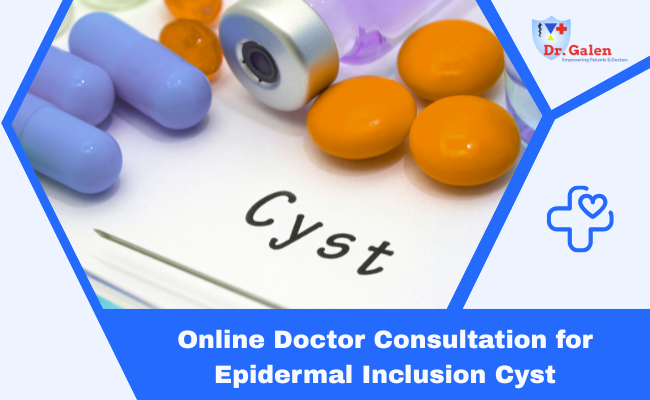What is Epidermal Inclusion Cyst ?
An epidermal inclusion cyst is a benign, slow-growing lump beneath the skin caused by trapped skin cells that form a sac filled with keratin. It commonly appears on the face, neck, back, or chest and is usually painless unless inflamed or infected.
Symptoms of Epidermal Inclusion Cyst
- 1. Small lump: Firm, painless, and stable over time
- 2. Itching: May cause mild skin irritation
- 3. Pain: Becomes tender if inflamed or ruptured
- 4. Swelling: Can feel warm, red, and swollen when infected
- 5. Drainage: Pore may release foul-smelling material
The Main Impact of Epidermal Inclusion Cysts
An epidermal inclusion cyst (EIC) is a benign, slow-growing cyst that can cause discomfort, infection, and cosmetic concerns, especially if located in visible areas. Infections can lead to redness, swelling, and abscess formation, while rupture may trigger inflammation and pain. Long-term neglect could even result in malignant transformation. Treatment usually involves draining infected cysts or surgical excision to prevent recurrence. Monitoring for changes and avoiding squeezing the cyst are essential, and consultation with a dermatologist or surgeon is recommended for proper care.
Consult Our Dermatologist
-
Dr. Julien Bachour, M.D DERMATOLOGIST : Specializes in dermatology, treating epidermal inclusion cysts with effective management.
-
Dr. Abdel-naser, MD, FACHARZT : Board-certified dermatologist with expertise in diagnosing and treating epidermal inclusion cysts.
-
Dr. Ibrahim Nafee, MD (Dermatology) : Experienced dermatologist known for a compassionate approach to diagnosing and treating epidermal inclusion cysts.
Importance and Benefits of consulting a Dermatologist online
It is essential to consult a healthcare professional for proper management of epidermal inclusion cysts (EICs), though not classified as a disease, are a common benign skin condition that can occur worldwide without being specific to any geographical region or country. Their occurrence is mainly influenced by factors such as genetics, hormonal changes, skin trauma, or blocked hair follicles, rather than environmental or regional causes. While generally harmless, proper management is essential, and consulting a healthcare professional is crucial, as they remain a notable health concern in many countries.
How Our Platform Connects You with Dermatology Specialists
Our platform simplifies the management of epidermal inclusion cysts by connecting you with experienced Dermatologists. You can easily browse specialist profiles, schedule video or audio consultations, and access electronic prescriptions or referrals for effective treatment. This streamlined and user-friendly system ensures a personalized healthcare experience tailored to your specific needs for managing conditions like epidermal inclusion cysts.
100% Refund Policy
We value your satisfaction and confidence in our services. If, for any reason, your consultation does not occur, we offer a 100% refund policy to ensure your peace of mind.
FAQ
Epidermal inclusion cysts develop due to the accumulation of keratin beneath the skin, often caused by blocked hair follicles, which trap keratin and other debris. Skin trauma, such as cuts or injuries, can push surface skin cells deeper, leading to cyst formation. Hormonal changes, particularly during puberty, and genetic predispositions, such as conditions like Gardner's syndrome, can also increase the likelihood of developing these cysts. In rare cases, improper healing after surgical procedures may result in trapped epidermal cells. These cysts are non-contagious and not associated with poor hygiene or infections.
An epidermal inclusion cyst can recur after removal if the entire cyst, including its wall or lining, is not completely removed during the procedure. If any part of the cyst lining remains, it can lead to regrowth. Proper surgical removal by a qualified healthcare professional minimizes the risk of recurrence. Additionally, recurrent trauma or blockage of hair follicles in the same area may also contribute to the return of the cyst.
You should see a doctor for an epidermal inclusion cyst if it becomes painful, grows rapidly, or changes in size. If signs of infection appear, such as redness, warmth, swelling, or foul-smelling drainage, it’s important to seek medical attention. A doctor should also be consulted if the cyst ruptures, leaks fluid, or causes discomfort that affects your daily activities. Any unusual changes in the cyst, such as increased hardness or bleeding, should also prompt a visit to a healthcare professional. Consulting a doctor ensures proper evaluation, treatment, and management to prevent complications.
While extremely rare, epidermal inclusion cysts can become cancerous if left untreated or if they are neglected for a long time. In very unusual cases, a cyst may undergo malignant transformation, such as developing into squamous cell carcinoma. However, this is not common, and most epidermal inclusion cysts are benign. Regular monitoring, timely treatment, and proper removal by a healthcare professional can significantly reduce the risk of complications, including the development of cancer. If you notice any changes in the cyst’s appearance or behavior, it's important to consult a doctor for further evaluation.
